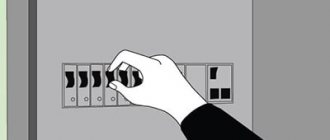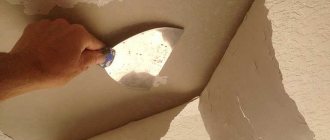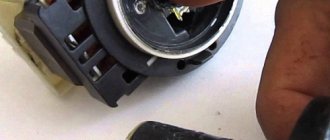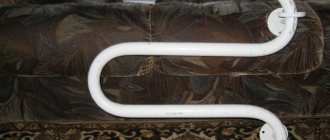Peeling paint on heating radiators significantly spoils the aesthetic appearance of both the heating system itself and the entire room. In addition, when carrying out painting work, before applying new enamel to the battery, the old one must be removed. Before removing paint from batteries, they must be thoroughly cleaned of dust. At the next stage, the radiators must be primed, and then, carefully, evenly apply new enamel to their surface in an even layer.
Most people (more than 40%) use radiators made of cast iron as their heating system. As a rule, they act as the main element of decor in a room, emphasizing the antique interior and design of the room. However, in some cases, replacing or removing cast iron radiators is not possible due to the nature of the heating system, which does not allow for its updating.
On a note! Before carrying out work related to removing outdated layers of paint from batteries, first of all, their surface must be cleaned of accumulated debris and dust. For these purposes, use an ordinary damp cloth or vacuum cleaner. If the paint is not flaking or flaking, you can use sandpaper to clean the battery.
Tools and tools
Before painting batteries and applying a new layer of paint to their surface, the previous layer must be properly removed. To do this you will need to acquire tools such as:
- Metal brush.
- Coarse sandpaper.
- Sanding attachments.
- An electric drill or angle grinder (angle grinder), preferably with a wheel diameter of no more than 150 mm.
Don't forget about safety precautions. When carrying out work to remove paint and varnish from the surface of radiators, it is recommended to use protective, durable glasses, rubberized gloves, and a respirator. To quickly remove enamel, as an alternative to metal brushes and sandpaper, you can use special chemicals. For example, Veslee 520 ml old paint remover is excellent for these purposes. Chemicals are preferably used to remove paint in hard-to-reach areas of radiators. For example, they are excellent for cleaning the surfaces of ribs.
Advice! When using chemical reagents to remove outdated enamel, it is recommended to use a respirator and ensure proper ventilation of the indoor air. In addition, before applying a chemical reagent to the surface, it must be cleaned with warm water and then dried.
Cleaning and priming the surface of radiators
If the procedure for removing paint from cast iron radiators is clear, and the composition can be completely removed, then it will be difficult to do this with new powder-coated radiators.
The smooth polymer surface is an obstacle to getting good adhesion between old and new paint. In this situation, there is only one way to remove paint from the battery - mechanical cleaning of the surface of the device with sandpaper.
When the gloss is removed and the old coating is cleaned, the entire radiator is degreased with white spirit, nefras or a similar solvent. Subsequent actions depend on the type of paint chosen. Enamels made on the basis of heat-resistant varnish or silicone can be applied directly to the metal, while alkyd and acrylic compositions require a base that ensures good adhesion of the new coating to the surface.
To extend the life of newly painted heating equipment, it is necessary to perform a high-quality primer, and the composition for this should be prepared in advance. The most popular brand is GF-021, which is intended for acrylic and alkyd paints. It is usually gray and red-brown in color.
Preparing for cleaning
It is preferable to carry out work to remove outdated enamel immediately before starting renovation work indoors, when preliminary preparatory work on the floors and walls has already been carried out. To carry out this removal procedure, you will need a spatula made of metal, a hard brush, and a simple rag.
Important! If cleaning of radiators is carried out after completion of repair work indoors, then in this case, the workplace where paint is removed must be properly insulated. To do this, you can use high-density paper or film.
It is preferable to remove paint and varnish material from removed radiators outdoors. However, this is not always possible. Regardless of the chosen cleaning method, mechanical or chemical, during work it is necessary to use rubberized or thick fabric gloves, a respirator, and safety glasses.
Enamel removal work must be carried out with the heating system turned off. Mechanical cleaning involves the use of abrasive agents, such as sandpaper. Liquid remover can be used for removal in hard-to-reach areas of the radiator, such as on the fins. However, it is not recommended to use the remover at the joints of battery sections where there are gaskets made of rubber.
How to clean a battery from old paint?
Korovin Sergey Dmitrievich Master of Architecture, graduated from Samara State University of Architecture and Civil Engineering. 11 years of experience in design and construction.
Before starting work on cleaning the heating radiator from paint, it is necessary to prepare the room. It is best to strip paint before work on finishing walls, ceilings and floors begins, since the process of removing old coating from a metal surface is associated with the formation of dust and dirt, which, under the influence of electromechanical tools, are scattered over a long distance.
The best option for handling the battery is to dismantle it. The removed radiator is taken outside and there they begin to remove the old coating using any of the possible methods - a sandblasting machine is especially effective, which can quickly and efficiently rid a metal surface of any type of paint.
To work at home, the master will need to prepare:
- respirator;
- protective glasses;
- thick thread gloves (if processing is carried out chemically, then you need to purchase thick rubber gloves).
Before starting work, it is recommended to disconnect the radiator from the heating network and thoroughly wash the battery, as dust and dirt will complicate the process of removing paint.
Cast iron radiators are the most unpretentious in choosing a method for removing old paint. For work, you can use all types of processing.
Old enamel is removed from an aluminum product using special neutral removers. They are applied for 15 minutes. Then the coating is easily removed with a spatula. It is not recommended to use mechanical processing for aluminum radiators to prevent scratches.
Removing the coating from bimetal requires care, since the product consists of aluminum and steel parts. To prevent deterioration in appearance, it is preferable to use chemical removers and avoid serious mechanical impact
Chemical paint remover
Most often, there is no way to find out what exactly the battery is painted with. Therefore, you have to purchase universal preparations that can dissolve several types of enamel. In the recent past, nitro paint and oil enamel were most often used for repair work. Both types can be removed well by AFT remover.
The water-based Paint & Varnish Stripper does not run off vertical surfaces and is economical. To treat a heating battery of 12 sections, approximately 1 liter of wash is sufficient. It works within 15 minutes.
To work you will need:
- chemical paint remover;
- Medium sized flat paint brush.
The remover can be applied with a paint brush, trying to evenly moisten all surfaces of the heating radiator with the composition. If the liquid is in an aerosol can, then it is sprayed according to the instructions. The composition acts within 30-60 minutes. At the same time, the old paint swells and softens. It can be removed quite easily with a spatula or knife. Cover areas that cannot be treated with the remover again.
After removing the paint, wash the radiator with warm soapy water. It is convenient to rinse the internal surfaces of the sections using a household sprayer. Wipe a clean battery with a cloth and dry it before painting.
Methods for removing old paint and a review of popular removers
How to remove old paint from a radiator? There are many proven methods that can effectively remove the outdated layer of paint from heating system radiators. The most effective and most common of them are the following methods:
- mechanical;
- chemical;
- thermal.
Each of the listed methods has its own specific advantages and some disadvantages. For example, the chemical method allows you to remove paints or water-based compounds from hard-to-reach places. It involves the use of such removal products as Maximum, Kompozit, Abro PR – 600 Paint Remover. A good product for removing enamel is a substance called Khimrezerv, body.
Removing old paint using an aerosol
Aerosols are chemical agents that allow you to remove outdated paint even in hard-to-reach areas of products. This paint removal method, which involves the use of chemicals made in the form of aerosols, is best used to remove, remove, and clean enamel on radiators or to remove the paint from radiators that were made of cast iron.
Important! Before using aerosols, it is necessary to remove objects made of plastic or rubber from the working surface on which it will be applied. To prevent aerosol from getting on the floor, it must be covered with film or very thick paper.
To remove the outdated layer of enamel, you need to take an aerosol and spray it on the surface of the battery. As a rule, in order to treat the radiator (external and external parts), you will need no more than one can of aerosol. After applying the product, after about 15-30 minutes, the old finishing layer will gradually begin to become covered with bubbles. It is worth noting that
the rate of reaction will directly depend on the temperature of the air inside the room.
Then, when the old enamel begins to peel off, it can be removed from the surface of the battery. For these purposes, you can use an ordinary metal brush. If it was not possible to completely remove the paint, then this procedure must be repeated again 2-3 hours after the first attempt.
Chemical remover
To remove enamel from radiators, you can also use special chemical removers, which are available in a large assortment in many hardware stores. The most common and effective option is to use a gel remover. Such chemicals contain special components that can destroy the layer of any cladding (paint or varnish).
The procedure for removing paint from batteries using chemical removers is carried out using a brush. However, this method has a big drawback. Washing these chemicals off the inside of batteries can be very difficult. When working with chemical removers, you should follow safety rules. These substances must be stored in the special container in which they are sold. It is not recommended to pour them into another container.
To clean radiators using chemical removers, you need to take a brush and dip it in the solution. Then, using broad strokes, the surface of the batteries should be treated with this solution. The duration of action of chemical removers, depending on the product used and the condition of the surface being treated, is no more than 5-15 minutes. Therefore, before the remover applied to the heating radiator has had time to dry, using a spatula or a metal brush, you need to remove the old layer of enamel. After work, the radiators must be thoroughly washed with soapy water and then dried.
Preparing the battery for painting - how to remove paint
Before you start painting the heating device, you need to figure out what removes old paint on radiators and carry out a number of preparatory measures. Otherwise, you will not get a new high-quality coating.
Before painting radiators, you should perform certain actions:
- Prepare tools and work area.
- Remove the previous coating and existing rust, having first found out how to remove old paint from radiators.
- Clean surfaces and degrease them.
- Apply primer.
The highest quality and most beautiful coating is obtained if it is applied to a dismantled device. If it was connected to the heating system using an American connection or special kits, then you can remove the radiator without any problems.
When it is firmly fixed, then before removing the paint from the radiator and applying a new composition, the walls and floor covering of the room must be protected from dirt by using plastic film or other materials. They also prepare tools and everything else for repairs in advance.
Thermal and mechanical cleaning method
The thermal cleaning method involves using high temperatures to remove old enamel from the surface of batteries. To do this, a jet of hot air is used, which can be obtained using a special construction hair dryer. When heated, the old coating will begin to peel off from the metal surface. To completely remove it, use a spatula or metal brush.
Advice! If several layers of paint are applied to the radiator, then in this case, instead of a hairdryer, it is preferable to use a blowtorch. However, when using such a lamp, combustion products that are dangerous to humans are released. Therefore, when using it. Work must be carried out outdoors.
The simplest in terms of execution, but at the same time the most labor-intensive and time-consuming, is the mechanical method of removing the old layer of enamel. The disadvantage of this method is that when using it it is very problematic to clean hard-to-reach places on the radiator.
The essence of the mechanical cleaning method is to use a variety of tools (spatulas, brushes, angle grinders, drills) to remove the outdated layer of enamel. This method also involves the use of coarse sandpaper.
Removing old paint from radiators: how to remove it yourself
How to remove old paint from radiators? This question worries many, because even cosmetic repairs often require painting radiators. An old cast iron radiator with peeling paint can ruin the entire appearance of the room. There is no need to apply fresh paint over the old coating. By doing this, you will only emphasize the relief of the radiator, which has formed over several years.
You will have to remove the old paint, prime the radiators and only then paint them again. There is no other way to turn an old radiator into a modern interior detail.
Start with the process of removing the old paint. There are 3 ways:
- surface heat treatment;
- mechanical removal;
- chemical wash.
Wait until the heating season ends, only then should you start cleaning and painting radiators. The fact is that the remover will not remove paint well from a hot battery, and the new layer of paint will dry unevenly. Because of this, the paint will quickly come off the cast iron surface. In addition, you will have difficulty working with a hot battery.
Buy all the necessary materials in advance. Prepare your tools, they will come in handy in any case. You will need the following equipment:
- metal spatula;
- brush with wire bristles;
- a supply of rags or old rags.
We remove paint from radiators on our own; it is better to clean the surface of the radiators immediately after preparing the room for repairs. In case you remembered this very late, simply isolate the part of the room where the work will be carried out. Use a thick film for this purpose, this will prevent dust from getting onto the already repaired surfaces.
Of course, the easiest way is to remove the radiator before starting cleaning, and then carry out all the work outdoors. But this cannot always be done, so take care to protect the premises. We should not forget about personal protective equipment. Prepare rubber gloves if you choose a chemical cleaning method. For all types of work you will need safety glasses, a respirator and fabric gloves.
Before you start cleaning the battery, thoroughly wipe off the dust. If there are pieces of paint coming off, remove the old enamel using a spatula.
Before you clean the batteries from paint, you need to go to a building materials store and buy a new paint composition there.
To paint heating appliances, it is necessary to choose heat-resistant paints, the basis for which can be:
- Acrylic . Water-based compositions, which include acrylic polymer, remain as bright and odorless for a long time. They can be given any shade you like by adding the appropriate pigment to the base enamel. Acrylic paint intended for application to the surface of batteries is designed for heating temperatures not exceeding 80 ºС.
- Alcides . The basis for such coloring compositions are organic solvents. The result is coatings that are stronger than acrylic ones. If you need to paint the radiator white or light color, it is better not to use alkyd enamel, since the surface of the devices will quickly turn yellow. Alkyd-based compositions can be used to paint batteries, but only in dark shades.
- Heat-resistant varnish . Aluminum or bronze powder is added to it.
- Silicone resin.
In order to give old cast iron radiators a more aesthetic appearance, two-component compositions are used. In them, heat-resistant varnish is mixed with powder, the color of which can be matched to silver, gold or bronze. Their cost is low, but at the same time they are well applied to devices and are durable.
Silicone coatings have similar properties, but such enamels are expensive. The process of applying them is simple, since they are sold in aerosol cans. Silicone-based compounds are sold in a wide range of colors.
When choosing a coating, first of all, take into account its thermal resistance.
Basic Safety Precautions
When carrying out work to clean the old paint layer from the surface of radiators, simple safety precautions must be observed. Regardless of the method for removing the outdated layer of enamel, all work must be carried out after wearing protective clothing and protecting the eyes and respiratory organs with goggles and a respirator.
On a note! The most dangerous to human health is chemical cleaning. When using chemicals, you must follow safety regulations for working with them. After all, such substances are caustic and toxic. Therefore, when working with them, you need to thoroughly ventilate the room and prevent them from coming into contact with the surface of the skin, use a respirator and wear gloves.











